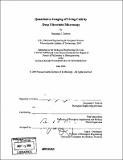| dc.contributor.advisor | Paul Matsudaira. | en_US |
| dc.contributor.author | Zeskind, Benjamin J | en_US |
| dc.contributor.other | Massachusetts Institute of Technology. Biological Engineering Division. | en_US |
| dc.date.accessioned | 2007-08-29T20:45:46Z | |
| dc.date.available | 2007-08-29T20:45:46Z | |
| dc.date.copyright | 2006 | en_US |
| dc.date.issued | 2006 | en_US |
| dc.identifier.uri | http://hdl.handle.net/1721.1/38693 | |
| dc.description | Thesis (Ph. D.)--Massachusetts Institute of Technology, Biological Engineering Division, 2006. | en_US |
| dc.description | Includes bibliographical references (p. 139-145). | en_US |
| dc.description.abstract | Developments in light microscopy over the past three centuries have opened new windows into cell structure and function, yet many questions remain unanswered by current imaging approaches. Deep ultraviolet microscopy received attention in the 1950s as a way to generate image contrast from the strong absorbance of proteins and nucleic acids at wavelengths shorter than 300 nm. However, the lethal effects of these wavelengths limited their usefulness in studies of cell function, separating the contributions of protein and nucleic acid proved difficult, and scattering artifacts were a significant concern. We have used short exposures of deep-ultraviolet light synchronized with an ultraviolet-sensitive camera to observe mitosis and motility in living cells without causing necrosis, and quantified absorbance at 280 nm and 260 nm together with tryptophan native fluorescence in order to calculate maps of nucleic acid mass, protein mass, and quantum yield in unlabeled cells. We have also developed a method using images acquired at 320nm and 340nm, and an equation for Mie scattering, to determine a scattering correction factor for each pixel at 260nm and 280nm. These developments overcome the three main obstacles to previous deep UV microscopy efforts, creating a new approach to imaging unlabeled living cells that acquires quantitative information about protein and nucleic acid as a function of position and time. | en_US |
| dc.description.statementofresponsibility | by Benjamin J. Zeskind. | en_US |
| dc.format.extent | 169 p. | en_US |
| dc.language.iso | eng | en_US |
| dc.publisher | Massachusetts Institute of Technology | en_US |
| dc.rights | MIT theses are protected by copyright. They may be viewed, downloaded, or printed from this source but further reproduction or distribution in any format is prohibited without written permission. | en_US |
| dc.rights.uri | http://dspace.mit.edu/handle/1721.1/7582 | |
| dc.subject | Biological Engineering Division. | en_US |
| dc.title | Quantitative imaging of living cells by deep ultraviolet microscopy | en_US |
| dc.type | Thesis | en_US |
| dc.description.degree | Ph.D. | en_US |
| dc.contributor.department | Massachusetts Institute of Technology. Department of Biological Engineering | |
| dc.identifier.oclc | 165103607 | en_US |
